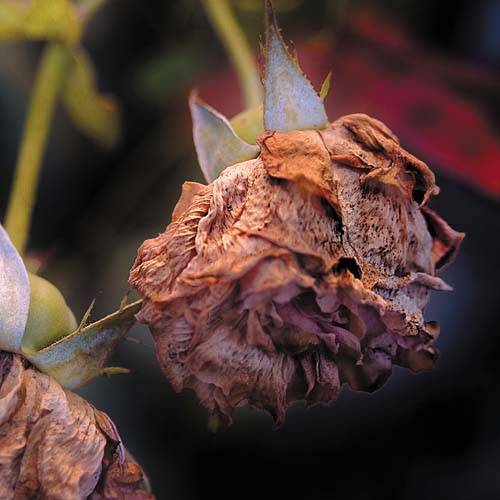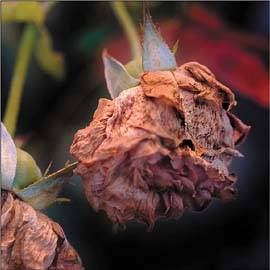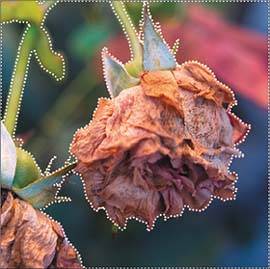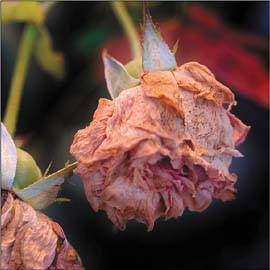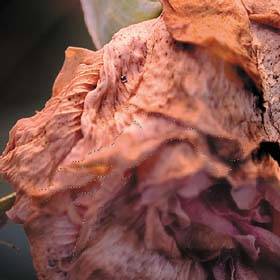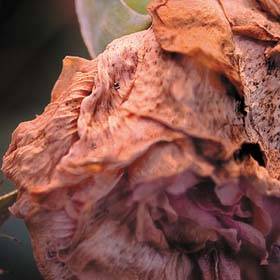Dramatic Shadows
|
You should think about adding dramatic shadows to a photo when you want to create an emotional edge or emphasize a specific area or feature of the subject. You might want to create deep shadows that obscure certain details in darkness, or create pools of light that spotlight an area. When adding dramatic shadows, it's also likely that you'll sharpen or blur certain areas in conjunction with the lightness and darkness. Throughout the process, you'll find that you're making decisions about what's important in the image. What's the main message and focus? How does the composition lead the eye to various areas of the image? These are things you could take into consideration as you start to make revisions. If the image already has an area of focus and emphasis, the task is one of emphasizing and accenting what's already there. Remember that you can also create an effective composition out of a mundane image by simply adding shadows and highlights in the right places. This exploration is good for things such as picking a person out of a crowd, shining a spotlight on an object, or creating a dramatic landscape. Make sure that you have an image with adequate detail and image quality so that it stands up to scrutiny when you draw attention to a specific area. Dried Roses
About the Original Image The original image for this effect was a photo called Dried Roses, shot at the abbey of Santa Anna in southern Tuscany. I love the texture on the top petals of the central rose, as well as some of the spotting on the right side. I wanted to bring that out more by sharpening the detail in those areas. I also wanted to remove some of the extra details that were distracting from what I wanted to set up as the focal area. The blurred background had a number of shapes and colors in it that created a busy pattern while adding nothing to the image. My plan was to darken down the entire background and pull focus to the top of the center rose. Building the EffectSimplification was my goal with the Dried Roses image because the undulating stalks, red color, and high contrast of the background created lots of unwanted detail and distracted from the main focal point of the top petals on the central rose. I selected the Magic Wand tool and made sure that the Anti-alias and Contiguous check boxes were enabled in the Options bar. I clicked in the blue background area while entering various Tolerance values in the Options bar. I found that a value of 22 was a great Tolerance setting that allowed me to select large background sections without impinging on the roses in the foreground. I held down the Shift key and selected various sections of the background until the entire background was selected, creating a silhouette around the central rose (Figure
With the selection still active, I chose Select, Save Selection; in the Save Selection dialog box that appeared, I typed Sharp in the Name field to name the selection. After clicking OK, I chose Select, Feather, entered a feather value of 100 pixels , and clicked OK to feather the selection. This command created a soft-edged selection that would work well to smooth out the background without leaving a harsh edge around the flower. Darken the BackgroundTo adjust the tones in the current selection, I selected Curves from the Adjustment Layer pull-down menu in the Layers palette to create a Curves adjustment layer above the main image layer. I set the Input/Output points to Input: 155, Output: 73. The result of this Curves adjustment is shown in Figure
To add more contrast in the highlight areas of the rose, I created an additional Curves adjustment layer with Input/Output points of Input: 78, Output: 8, and Input: 221, Output: 250. Although this adjustment deepened the shadows, it also oversaturated the color. To compensate I selected Hue Saturation from the Adjustment Layer pull-down menu in the Layers palette tov create a new adjustment layer, and set the Saturation slider to -47 (see Figure
Fix the BlurI liked where things were going but there was a big out-of-focus area right in the middle of the flower. I knew that I couldn't restore sharp focus to an area that was this soft, but I wanted to try to bring out a bit more contrast. To do this, I selected the Pen tool and chose the Path mode from the Options menu instead of using the default Shapes mode. I then drew a path that defined the edges of the petals in the blurry area, clicking to add anchor points that would define the area. I used the Option key (Alt in Windows) to switch from smooth to angled corners, and the
I used the Dodge and Burn tools to deepen the shadows and brighten the highlights in the blurred area. In the Options bar, I set the range for the Burn tool to Midtones or Shadows as needed, and painted into the shadow areas of the petals to darken and sharpen. I set the range for the Dodge tool to Highlights and went back over the edges of the petals, bringing out the highlights and creating a deeper illusion of space. I kept the Exposure settings for all these adjustments between 6% and 12%. With the selection still active, I selected the Clone Stamp tool with a 30-pixel brush, and added detail into the light areas of the petals. I Option-clicked (Alt-clicked in Windows) the source point on areas where the lines and textures flowed in the same direction, and added these details sparingly so that the effect did not appear artificial or plastic (see Figure
Apply Global SharpeningFinally,I decided to add some global sharpening using the High Pass filter. I chose Select, All to select the entire image and then chose Edit, Copy Merged to copy all visible layers. I then selected Edit, Paste to paste the composite design as a single layer. I selected Filter, Other, High Pass, set the Radius slider to 4.2 pixels, and clicked OK to apply the effect. With the new filtered layer at the top of the stack, I experimented with blending modes for the High Pass filter layer. Hard Light sharpened the petals on the left, while Vivid Light created additional separation on the right. To apply both blending modes, I duplicated the High Pass layer, set one layer's blending mode to Hard Light, Option-clicked (Alt-clicked in Windows) the Add Layer Mask icon in the layers palette to hide the layer, and painted with white to reveal just the petals on the upper-left of the central flower. I set the other layer's blending mode to Vivid Light and followed the same process to reveal the the details in the spotted petal on the right (see Figure
|
EAN: 2147483647
Pages: 141
